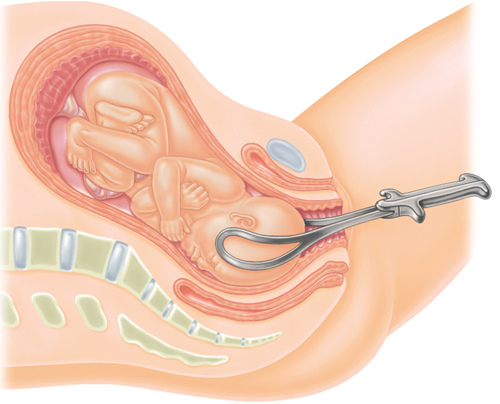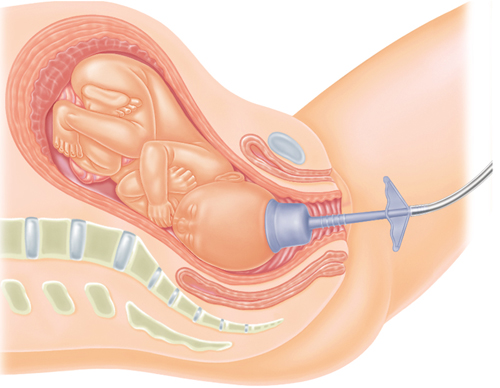Assisted Birth
In the US, 4.8 percent of babies has an assisted birth. These are considered safe and can prevent further complications.
An assisted birth is a birth
in which either forceps or a vacuum suction cup (also called a vacuum or
ventouse extractor) are used to aid a vaginal delivery. There may be
some mild side effects such as bruising after an assisted birth, but
major complications are rare.
As with all
medical interventions, the use of forceps or a vacuum extractor will
only be offered when it is thought to be necessary for the health of the
baby and/or mother.
The procedure
First, your doctor will
discuss with you the need for the procedure and may also explain to you
the potential complications. You may be asked to sign a consent form,
although not all hospitals insist on this. Before the birth takes place,
you will probably be given an episiotomy and local anesthetics or
epidural anesthesia. Fresh covers may be placed over your legs and
abdomen and a catheter will be inserted to empty your bladder. The
doctor will then place the forceps around the baby’s head or attach the
vacuum cup and will encourage you to start pushing again when you have a
contraction. Your baby should be born within around another 20 minutes
from this time. There is less of a risk for a vaginal injury with a
vacuum extraction than there is with forceps.
Forceps
Modern surgical
forceps were invented by the British doctor Chamberlen in the
seventeenth century and so have been in use for hundreds of years,
although they have been modified over time. Forceps are an effective and
reliable way to assist a delivery, but they have to be used with care
by a properly trained doctor.
The forceps are placed
so that they hold the sides of the baby’s head near the ears and cheeks.
The operator of the forceps then gently pulls the baby’s head downward
while you push during a contraction, and then will guide the baby out of
the birth canal.
Forceps can also be
used to adjust the baby’s head before the birth if the baby is lying in
an occiput posterior position, which is with his back facing the
mother’s back,
toward the end of labor. After turning the baby’s head and body,
delivery is then completed as in the same way as described above.
Pros and cons of forceps
There are several
advantages of forceps over vacuum. First, they do not rely on any kind
of machinery that could cause a problem during the birth. They also work
well even if your contractions are weak or if you are finding it hard
to push due to exhaustion. Lastly, forceps have a low failure rate: if
the doctor can get the forceps around your baby’s head easily, he will
usually be able to complete the vaginal birth of your baby without
having to resort to a cesarean. The disadvantage of forceps is that you
may be more likely to have vaginal or perineal damage than with vacuum.
Vacuum extractor
The vacuum, or vacuum
extractor, was invented in the 1950s. It consists of a cup attached to a
tube that connects to a suction pump. The cup, which can be hard or
soft plastic or metal, is placed on top of the baby’s head and held in
place while the suction creates a vacuum that makes the cup adhere to
the baby’s scalp. The doctor pulls downward while you push during a
contraction.
Vacuum births are
known to be very safe as long as you are at least 34 weeks pregnant.
Before this time your baby’s head may be too fragile to deal with the
suction and few doctors use a vacuum before 32 weeks.
Pros and cons of vacuum
The vacuum has
some advantages over forceps; it is often a little easier to apply and
may be less uncomfortable for you. It is also less likely to cause
vaginal and perineal damage and you will be less likely to need an
episiotomy. However, vacuum fails in up to 20 percent of cases, and it
is especially likely to fail if your baby is not in the ideal position
for the birth. Some doctors think it is also more likely to fail if your
contractions are weak, if there is already a lot of natural swelling on
your baby’s head, or if you are too tired to push. If a vacuum does
come off during the birth, it can be reapplied, or the doctor can reach
for a pair of forceps instead. Sometimes, however, a cesarean section
has to be performed if the vacuum fails.
Pain relief
It can be painful
having an assisted vaginal birth, so it is important that you have
sufficient pain relief to help you cope with the delivery. In some
situations, an injection of a local anesthetic in and around the vagina
is sufficient to help you deal with the pain, particularly if the doctor
is anticipating the birth to be fairly quick, and if your baby has
already traveled most of the way through your pelvis. For more difficult
assisted births, for example where the baby is not in an occiput
anterior position, an epidural may be given.
This is especially useful if you’re going to give birth in the
operating room instead of the delivery room because forceps or vacuum
have a high chance of failing, leading to the need for a cesarean.
Finally, if you already have an epidural in place, this can be topped up
with additional medication if necessary.
Reasons for an assisted birth
There are several factors that can make an assisted birth more likely.
Your baby has an abnormal heart rate, which suggests that he might be in distress.
You have been pushing a long time, but your labor is progressing slowly.
You’re exhausted and can’t manage any more pushing.
You have a medical condition and have been told not to push for long.
Methods of assisting birth
Assisting your baby’s birth with vacuum or forceps
is a safe, well practiced procedure, which can prevent the need for an
emergency cesarean. Whether you have forceps or vacuum may depend on the
particular expertise and experience of the doctor doing the procedure.
With forceps, your baby’s head is cradled on either side with metal tongs that guide him down in time with your contractions.

With vacuum, a soft suction cup is attached to your baby’s head and then your baby is gently guided out.

Possible complications
In the majority of cases, both the mother and baby are perfectly well after an assisted birth, but occasionally complications are encountered.
Problems during the delivery
A condition known as
shoulder dystocia, in which the baby’s shoulders become stuck during the
birth, is more common with a forceps or vacuum delivery. If the
shoulders get stuck, simple maneuvers usually release them without great
difficulty, but very rarely, a shoulder dystocia can turn into an
emergency, and your doctor may have to perform special maneuvers or even
an emergency cesarean to complete the baby’s birth.
How your baby may be affected
Forceps can leave a
temporary bruise on the side of your baby’s face and can even put
pressure on a nerve near the eyes, stopping the baby from being able to
blink properly for a day or two. In contrast, the vacuum tends to leave a
bruise on the top of the head rather than on the face (and the head may
appear elongated at first where the suction pressure was applied). This
can look a little alarming, but it will disappear after a couple of
weeks. More severe complications for your baby, which can include a
fractured skull bone after a forceps delivery, or bleeding inside the
skull after a vacuum, are very rare.
How you may be affected
You’re more likely to be
given an episiotomy cut, particularly during a forceps delivery, to
protect your back passage from more severe damage during the birth. This
is usually successful, but in some cases an extra tear may occur in the
back passage and careful stitching, after delivery is required to
repair the area. Stitches may also be used if you get other tears in or
around the vagina.
A medio-lateral cut is usually done into the muscle, angled away from the vagina and the perineum.